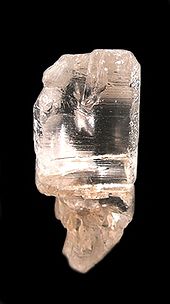This is an old revision of this page, as edited by Vsmith (talk | contribs) at 13:36, 23 October 2011 (fixes plus a bit). The present address (URL) is a permanent link to this revision, which may differ significantly from the current revision.
Revision as of 13:36, 23 October 2011 by Vsmith (talk | contribs) (fixes plus a bit)(diff) ← Previous revision | Latest revision (diff) | Newer revision → (diff)| Petalite | |
|---|---|
 Petalite from Minas Gerais State, Brazil (size: 3x4 cm) Petalite from Minas Gerais State, Brazil (size: 3x4 cm) | |
| General | |
| Category | Tectosilicate |
| Formula (repeating unit) | LiAlSi4O10 |
| Strunz classification | 09.EF.05 |
| Crystal system | Monoclinic |
| Space group | Monoclinic prismatic H-M symbol: (2/m) Space group: P 2/a |
| Unit cell | a = 11.737 Å, b = 5.171 Å, c = 7.63 Å; β = 112.54°; Z = 2 |
| Identification | |
| Color | Colorless, grey, yellow, pink, to white |
| Crystal habit | Tabular prismatic crystals and columnar masses |
| Twinning | Common on {001}, lamellar |
| Cleavage | Perfect on {001}, poor on {201} with 38.5° angle between the two |
| Fracture | Subconchoidal |
| Tenacity | Brittle |
| Mohs scale hardness | 6 - 6.5 |
| Luster | Vitreous, pearly on cleavages |
| Streak | Colorless |
| Diaphaneity | Transparent to translucent |
| Specific gravity | 2.4 |
| Optical properties | Biaxial (+) |
| Refractive index | nα=1.504, nβ=1.510, nγ=1.516 |
| Birefringence | δ = 0.012 |
| 2V angle | 82 – 84° measured |
| Melting point | 1350 °C |
| Fusibility | 5 |
| Solubility | Insoluble |
| References | |
Petalite, also known as castorite, is a lithium aluminium tectosilicate mineral LiAlSi4O10, crystallizing in the monoclinic system. Petalite is a member of the feldspathoid group. It occurs as colorless, grey, yellow, yellow grey, to white tabular crystals and columnar masses. Occurs in lithium-bearing pegmatites with spodumene, lepidolite, and tourmaline. Petalite is an important ore of lithium, and is converted to spodumene and quartz by heating to ~500 °C and under 3 kbar of pressure in the presence of a dense hydrous alkali borosilicate fluid with a minor carbonate component. The colorless varieties are often used as gemstones.

Discovered in 1800, type locality: Utö Island, Haninge, Stockholm, Sweden. The name is derived from Greek petalon for leaf.
References
- "Petalite". Digital Fire. Retrieved 23 October 2011.
- Handbook of Mineralogy
- Webmineral
- ^ Mindat
- *Hurlbut, Cornelius S. and Klein, Cornelis, 1985, Manual of Mineralogy, Wiley, 20th ed., pp. 459-460 ISBN 0-471-80580-7
- Framework silicates: silica minerals, feldspathoids and the zeolites (2. ed. ed.). London: Geological Soc. 2004. p. 296. ISBN 1862391440.
{{cite book}}:|edition=has extra text (help);|first=missing|last=(help)
This article about a specific silicate mineral is a stub. You can help Misplaced Pages by expanding it. |